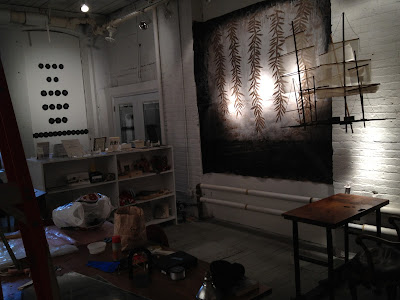A wonderful article about my work by Sasha Chavchavadze from Proteus Gowanus.
Proteoscope
The Blog of Proteus Gowanus
Blog
Robert Gould – The Tree Still Stands
Robert Gould finds constants through nature. While reading Georgia Fraser’s
1909 book “The Stone House of the Gowanus,” he encountered a description of an
old willow tree that was thought to date back to the time of the Battle of
Brooklyn. Though Gould thinks the story is apocryphal, it propelled him to
search for a willow branch, trace its leaves, which he applied to an 87″ x 92″
painting. On each leaf he wrote the name of a Maryland soldier, many of whom
were slaughtered in the culminating moments of the battle. Sometimes Gould uses
dirt or crushed brick from battle sites as a painting medium.
These are not paintings that translate American Revolutionary imagery into kitsch or pop images as Larry Rivers did when he painted “Washington Crossing the Delaware.” Nor are they a jingoistic attempt to glorify, simplify or “re-enact” this dramatic event that took place in 1776. There is a sense of irony and loss in Gould’s paintings, which attempt to inhabit the “skin” of this forgotten moment, reliving its pathos. But the nostalgia here is not a longing to return, rather an attempt to use the past as a “medium” to integrate the present.
Could there be an unhealed “wound” in this forgotten battle, one of only two full-scale military invasions sustained by this country (the other was during the War of 1812)? Interestingly, when asked for his sources of inspiration, Gould cites the German artists Joseph Beuys and Anselm Kiefer. These artists were processing the brutality of World War II. Why, one might ask, didn’t American visual artists of the same generation use their wartime experiences as source material? The simple answer might be that World War II never reached U.S. soil. But American artists of that time seemed rooted in the “new,” wedded to a timeless formalism that considered any kind of nostalgia anathema.
Gould’s pinhole camera images of battle sites, photographed with a refitted
toy camera, telescope time and space, peering into the past. Contemporary urban
sites where the battle was fought are photographed simply as they are today. The
images, such as “The Witness Tree,” an oak that stands today on a golf course,
speak silently and directly about forgotten knowledge.




These are not paintings that translate American Revolutionary imagery into kitsch or pop images as Larry Rivers did when he painted “Washington Crossing the Delaware.” Nor are they a jingoistic attempt to glorify, simplify or “re-enact” this dramatic event that took place in 1776. There is a sense of irony and loss in Gould’s paintings, which attempt to inhabit the “skin” of this forgotten moment, reliving its pathos. But the nostalgia here is not a longing to return, rather an attempt to use the past as a “medium” to integrate the present.
Could there be an unhealed “wound” in this forgotten battle, one of only two full-scale military invasions sustained by this country (the other was during the War of 1812)? Interestingly, when asked for his sources of inspiration, Gould cites the German artists Joseph Beuys and Anselm Kiefer. These artists were processing the brutality of World War II. Why, one might ask, didn’t American visual artists of the same generation use their wartime experiences as source material? The simple answer might be that World War II never reached U.S. soil. But American artists of that time seemed rooted in the “new,” wedded to a timeless formalism that considered any kind of nostalgia anathema.
Robert Gould, The Witness Tree






















.JPG)

















